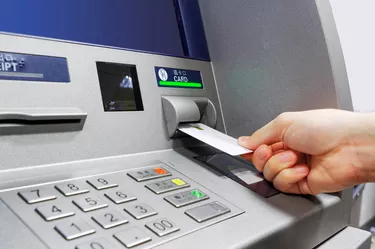Automated Teller Machines (ATM) machines are placed at banks, grocery stores, convenience stores and other locations throughout the country. Easy access to cash is convenient, but what happens if a customer forgets to take his card at the end of the transaction?

Types of Card Readers
ATMs in the United States can have one of three types of card reader. Dip readers are those in which the customer inserts his card partway and then quickly removes it. Swipe readers are those that ask the customer to swipe his card through the reader, similar to a traditional credit card machine. Neither of these readers can "keep" a card during a normal transaction. Traditional card readers are those that pull the card into the ATM at the beginning of the transaction and give it back at the end. A card can fall into a dip reader if the back plate is broken, but most ATMs that "keep" cards are fitted with traditional-style readers.
Video of the Day
Video of the Day
Security Settings
ATMs with traditional card readers are programmed to automatically re-accept an abandoned card and drop it into a special tray in the vault (the secure area of the ATM that holds the cash and deposits) if the customer does not remove it within a certain timeframe. The ATM owner can set the amount of time customers have to take their cards at the end of a transaction before the machine automatically re-accepts the card, but 30 seconds is standard. This process exists to protect forgetful customers from thieves who would take forgotten cards from the ATM and use them.
On-site Bank ATMs
If an ATM is located at a bank, the bank owns the ATM. Smaller banks and remote branches often use bank personnel to settle (stock cash, remove deposits and run end-of cycle programming) their ATMs. In this case, the abandoned card will be retrieved by bank personnel and can usually be returned to the customer at the bank. They may be able to retrieve the card immediately or the customer may have to wait until their next service cycle, depending on bank policy. Larger banks pay service companies to settle their on-site ATMs. In this case, the service company will remove the card from the machine and hand it over to the bank with the deposits.
Off-site Bank ATMs
Bank-owned ATMs that are placed in locations other than the bank itself are always settled by a service company (usually an armored transport service). They will remove all cards from the machine on the scheduled service date. However, what they do then depends on the bank and on the contract. Some contracts require the service company to return the cards to the bank's regional or national headquarters. Other contracts state that the servicer must immediately destroy all cards found in the ATM and dispose of the remains in a secure location. Store personnel do not have access to bank-owned ATMs.
Third-Party ATMs
ATMs placed at grocery stores, convenience stores, malls and other locations may be owned by any number of other entities, including the merchant. The greater majority of these machines are settled by a service company who will retrieve any abandoned cards. The standard service contract requires the service company to immediately destroy all cards found in the ATM. Cards are transported back to the secure central office along with the cash where they are shredded and disposed of securely. On rare occasions, a merchant may settle his own ATM. However, in these instances, the machine is almost always equipped with a dip or swipe reader and abandoned cards are not an issue.
Auto-Shred Feature
Some ATM machines are equipped with an auto-shred feature that destroys all abandoned cards and deposits the pieces into the reject tray. In this case, whoever services the machine is responsible for disposing of the pieces in a bank-approved, secure manner. The pieces cannot simply be dropped into a public waste basket where a thief could access them.